National Archaeology Museum (Portugal)
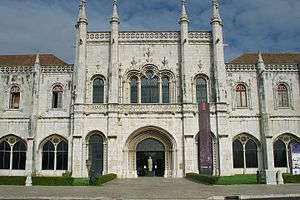 | |
| Established | 1903 |
|---|---|
| Location | Praça Império, Belém, Lisbon, Portugal |
| Coordinates | 38°41′50″N 9°12′25″W / 38.69728°N 9.20706°WCoordinates: 38°41′50″N 9°12′25″W / 38.69728°N 9.20706°W |
| Type | Archaeology Museum |
| Website | http://www.museuarqueologia.gov.pt/ |
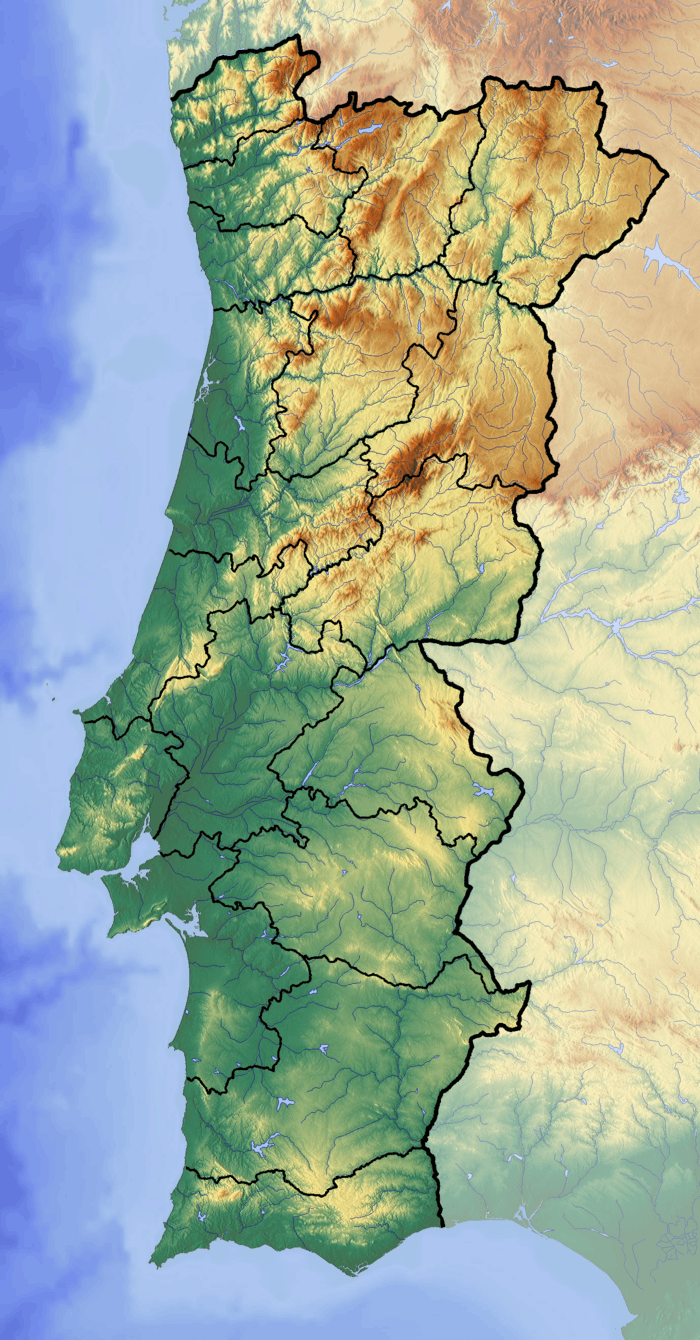 Location of National Museum of Archaeology (Portugal) | |
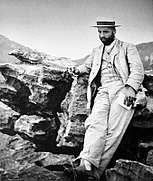
The National Museum of Archaeology (Portugal) (Portuguese: Museu Nacional de Arqueologia) is the largest Archaeological museum in Portugal and one of the most important museums in the world devoted to ancient art found in the Iberian Peninsula. Located in Lisbon, the museum was founded in 1893 by the archaeologist José Leite de Vasconcelos. The museum is located in the western wing of the Jeronimos Monastery where the monks had their dormitory. The museum is built in the neo-manueline style and was officially opened in 1906.[1]
The museum is the result of José Leite de Vasconcelos' efforts to create an archaeological museum dedicated to the history of Portuguese man. With the support of the politician Bernardino Machado, a legal decree for the creation of a National Ethnographic Museum was established on 20 December 1893.[2]
Over the course of its existence, the museum has changed name four times. Since 1989 the museum has assumed the name, The National Archaeology Museum of Dr. Leite de Vasconcelos.
The museum was given the international "Genio Protector da Colonia Augusta Emerita" prize, awarded by the Foundation for Roman Studies and the Friends of the National Museum of Roman art in Mérida, Spain.[3]
The museum is the most important centre for archaeological research in Portugal.
Collection
Part of a series on the |
|---|
| History of Portugal |
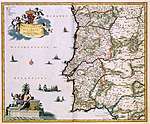 |
| Timeline |
|
|
The museum's archive consists of Leite de Vasocnelo's initial collection and multiple others: either donated to the state, incorporated from other museums or the result of the extensive archaeological explorations carried out by the museum and its staff.[4] The museum's archive, boasts items from over 3.200 archaeological sites[5] and covers over 500.000 years of the Iberian Peninsula´s history. It has the biggest musicological collection of Roman mosaics in Portugal and an important collection of Portuguese and African ethnography.[6] The museum's archive is available for consultation via MatrizNet.
%2C_I_d.C._-_II_d.C.%2C_%C3%89poca_Romana%2C_Romano_Lusit%C3%A2nia.jpg)
Main Collection
The main nucleus of the collection consist of arcaica jewelry kept in the Treasures exhibition room, it is one of the most important collections of its kind in the Iberian Peninsula.
Of equal importance are the museum's collections of epigraphy, of which the collection from the Sanctuary of S. Miguel da Mota (from the Endovelicus period) is of particular importance, as are its Roman Mosaics a few of which are National Treasures of Portugal.
Metal Artifacts
The museum's metalwork collection is representative of the mineral and metallurgical history of the Iberian Peninsula, which includes tools created in copper from the Chalcolithic period (middle of the 3rd century BC). Also in its collection are the oldest iron tools found in Portugal found in tombs located in the Alentejo region dating to the first Iron Age (7th-6th Century BC). Of particular importance are a group of artefacts named the "Atlantic Bronzes" and farming tools from the Roman Period.
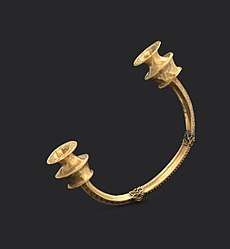
Sculpture
The museum also has the largest collection of Classical Sculpture in Portugal. From this period, items of particular technical and stylistic value are the toga'd statues from Mertola, Apollo from the Herdade do Álamo (Alcoutim) and the sarcophagi from Tróia and Castanheira do Ribatejo. Of note is the collection found in the Sanctuary of S. Miguel da Mota, which is the largest collection of its kind sculpted in Vila Viçosa/Estermoz type marble. The latter collection was found extensively vandalised, it is presumed this was the result of iconoclasm carried out by early christian communities.[7]
Emblematic of the Celtic period in North-eastern Portugal, are the monumental granite statues representing princes or noblepeople, often referred to as the "Gallecian Warriors" which guard the museum's entrance. The museum has the largest and most significant collection of Gallecian sculpture in the Iberian Peninsula. Also in this collection are the "Verraco" zoomorphic sculptures, probably created for totemic purposes.
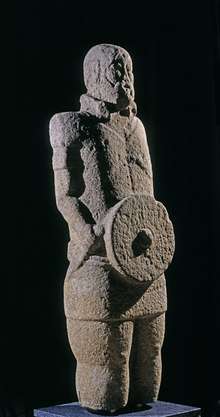
Roman Mosaics
Even though many Roman mosaics have been found in Portugal, this collection cannot be considered of international importance, especially when compared to collections in neighbouring Spain and Northern Africa. Nevertheless within this collection, the most important items are mosaics from the Roman Villas of Torre da Palma, Santa Vitória do Ameixal, Milreu and Montinho das Laranjeiras. The most common themes found in these mosaics come from classical mythology: The Journey of Odysseus, Orpheus, the Labour of Hercules. Almost all the mosaics date to the 3rd Century BC.
Gold Jewelry
The museum's collection, built over more than have a century has over 1.000 items of gold jewllery dating from Pre-History to Ancient History. The collection which was kept from the publis is now available for all to see, and displayed chrono-culturally. Some of the most important items found in this collection are: the treasures of the Herdade do Álamo and Baião, the Arrecadas from Paços de Ferreira on the notable Torc of Vilas-Boas.
Epigraphy
José Leite de Vasconcelos was a noted epigraphist, on account of his love for epigraphy, the museum boast one of the best national collections of epigraphy. The vast majority of the collection is of Latin Epigraphy, and tombstones. The museum also holds a collection of important Early Christian epigraphy.
Characterised by three motives - funerary, votive and honorific. Templates obeying predefined formula were often used for Roman Imperial latin epigraphy. Inscriptions such as D.M.S. (dis manibus sacrum), H.S. E. (hic situs est) e S. T. T. L. (Sit Tibi Terra Levis) leave no doubt as their funerary nature. The museum also holds a notable collection of votives to an indigenous divinity from the Endovelicus period located in the Sanctuary of São Miguel da Mota. Although in lesser numbers, there are also honorific epigraphs, which, amongst others, include the Civitas Ammaiensis to Emperor Claudius (imperial cult).
Medals & Coins
The museum has a small medals collection, its coin collection consists primarily of coins from the Portugal's roman period. There are over 30.000 roman coins, in the museum's archives which include some of the first coins used in Lusitania. The vast majority of this collection comes from several collections from the Roman Republican period a significant collection was found in the Santana da Carnota and in Mértola, from the late Roman Period, a 3rd Century AD collection was found in Porto Carro and from the 4th Century AD a collection was found in Tróia.
_Romana_Museu_Nacional_de_Arqueologia_Portugal.tif.jpg)
Organic Materials
The fragile and difficult nature of preserving organic materials, led to the development of special storage facilities in the museum, where such materials could be stored in a controlled environment. In this deposit are: items such as wooden step ladders and ropes from Roman mines located in Vipasca (Aljustrel), mummified remains, baskets and items made from leather belonging to the Egyptian Collection.
Ancient Egypt
The Collection of Ancient Egyptian art contains over 500 items, of which 300 can be found on display. The has several origins, the bulk of the nucleus was purchased by José Leite de Vasconcelos in 1909 during his visit to Egypt, later the collections of Queen Amélie of Orléans and of the Palmela Family were added. Despite its relatively small size, this collection covers the history of Egypt from the pre-dinastic to the Coptic eras.
_Romana_Museu_Nacional_de_Arqueologia_Portugal.tif.jpg)
Greco-Roman World
The museum contains holds a diversity of items stemming from the Greco-Roman Mediterranean from the Classic and Pre-Classic period. In this collection, amongst others are the items collected by José Leite de Vasconcelos in Greece, along with items purchased at auction as happened recently with an ancient Panathenaic Amphora originating from Pompeii or Herculaneum.
_Romana_Museu_Nacional_de_Arqueologia_Portugal.tif.jpg)
Ethnography
According to the scientific beliefs of the time, Ethnography was central to museum's underpinnings. To this effect, José Leite de Vasconcelos traveled through numerous regions, obtaining artifacts, which are to this day at the core of the National Museum of Archaeology and the National Museum of Ethnology's collections. Of particular note are the nuclei of Popular Religious Art which contain religious iconography, votive offerings, votive panels, amulets, and pastoral arts (spoons, horns, gunpowder horns) items with keys, musical instruments (including an 18th Century Accordion), toys, and smoking paraphernalia, Portuguese faience from the 17th to 20th centuries from several factories and periods, as well as pottery from Barcleos, Gaia, Caldas da Rainha, Mafra, Nisa, Estremoz, Redondo and the Algarve.
There are also African artworks of particular importance is the Tshokwe sculpture representing the warrior "Tshibinda Ilunga".
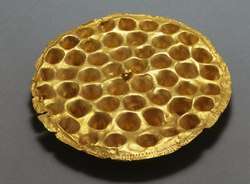
Amphorae
The collection of Amphora in the National Museum of Archaeology is an important testament of the socio-economic relations between the province of Lusitânia and the great economic epicenters of the Roman World. Lusitania's geographic location, situated in between the Atlantic Coast and the Mediterranean Sea, allowed archaeologists to find archaeological remains dating form the 1st century BC to the 5th Century AD.
The Amphora in the Museum's Collections are today part of a collective study on the complex maritime trade routes of the Roman Empire. Archaeological sites in Mértola, Castro Marim, Torre de Ares and Troia have revealed commercial ties between the oriental and western Mediterranean and the North of Africa through the importation of the famous Baetic olive oil and wine found in amphora type Dressel 20, Dressel 14, Haltern 70 e Africana I e II. One cannot fail to mention the many the many amphora created in Lusitania, namely Almagro 51 C, Almagro 51 a-b, Lusitana 3, Almagro 50, Dressel 14, which were used to store a range of goods, from fish conserves to luxury products such as scented sauces referred to by classic writers as garum ou o liquamen.
Location
_Lissabon%2C_Bel%C3%A9m%2C_Mosteiro_dos_Jer%C3%B3nimos.jpg)
The Museum is located in Lisbon in Santa Maria de Belém in the Mosteiro dos Jerónimos in a building from the 1800s which on 20 November 1900 granted by the government of the time to the museum, the museum takes up almost the whole of the part of the Mosteiro dos Jerónimos that faces the Praça do Império.[8] This is an area of high tourism influx on account of its multiple museums and heritage sites.
Throughout the years, the National Museum of Archaeology has been the subject of multiple reorganizations of its space and collection in order to better serve its collection. The National Museum of Archaeology started by being based in Lisbon's Academy of Sciences in room provided by the Geological Commission, it was then in 1903 moved the Mosteiro dos Jerónimos[9] and on 22 April 1906[10] it opened its doors to the public. It's reported that José Leite de Vasconcelos was radiant about this move.[11] However, because the museum became the national deposit of archaeological findings its size increased significantly.[12] In order to solve the physical limitations of its deposit, in th 1950s it was suggested that the museum move part of its deposit to the Lisbon University Campus,[13] it has also been suggested that the museum move to the Cordoaria Nacional.[14]
Mission
The museum was conceived by José Leite de Vasconcelos to be the "Museum of Portuguese Man",[15] a dream that grew as his archaeological work progressed.
As a museum with over a hundred years of history its name has changed on multiple occasions, recently in 1989 it was decided that the museum should be called, the National Museum of Archaeology - Dr. Leite de Vasconcelos.[16]
The Directors that followed, supported multiple archaeological excavations, the finds of which entered the museum. The majority of research carried out however, has focused primarily on the museum's already existing collection.The National Museum of Archaeology continues today, with the same basic mission to tell the history of people in Portugal's national territory, from their origins to the birth of the nation. The country's main center for archaeological research is located within the museum.
Besides research and education, the museum is also the national deposit and space for exhibitions of an archaeological nature.The museum also regularly publishes the Portuguese Archaeologist, a publication which has existed since 1895 and is the most important of its kind in Portugal.
Gifts & Donations
The National Museum of Archaeology has, in its short history benefited form several important Gifts and Donations, which have enriched its collections. Of particular importance have been the donations of António Bustorff Silva, D. Luis Bramão and the Sam Levy Family.
Selected Works
 Gold disc (verso), gold, Bronze Age
Gold disc (verso), gold, Bronze Age Set of buttons, gold leaf, Iron Age
Set of buttons, gold leaf, Iron Age Archer's pull-handle (verso), Bronze Age
Archer's pull-handle (verso), Bronze Age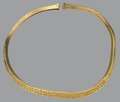 Gold necklace, Iron Age
Gold necklace, Iron Age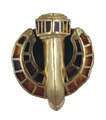 Gold and granate belt buckle, Late Antiquity
Gold and granate belt buckle, Late Antiquity Skewer with a bronze stand, Late Bronze Age
Skewer with a bronze stand, Late Bronze Age%2C_I_d.C._-_II_d.C.%2C_%C3%89poca_Romana%2C_Romano_Lusit%C3%A2nia.jpg) Female Bust (Júlia), 1-2nd Centuries AD, Lusitania, Roman Period
Female Bust (Júlia), 1-2nd Centuries AD, Lusitania, Roman Period_Verso%2C_MNArqueologia.tif.jpg) Female Bust - Julia (verso), 1-2nd Centuries AD, Lusitania, Roman Period
Female Bust - Julia (verso), 1-2nd Centuries AD, Lusitania, Roman Period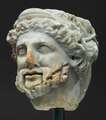 Male bust (Dionysus), 1st Century AD, Roman Period
Male bust (Dionysus), 1st Century AD, Roman Period_MNArqueologia.jpg) Statue of Apollo, 2nd Century AD, white marble, Roman Period
Statue of Apollo, 2nd Century AD, white marble, Roman Period Set of pine shaped votives, 3rd Century BC, Copper Age
Set of pine shaped votives, 3rd Century BC, Copper Age Stone with tartessian writing, black slate, Iron Age
Stone with tartessian writing, black slate, Iron Age Altar to Tiberius Claudius, 3rd Century AD, Roman Period
Altar to Tiberius Claudius, 3rd Century AD, Roman Period Hospitaliy Plaque, Roman Period
Hospitaliy Plaque, Roman Period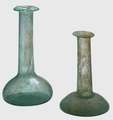 Unguentarium from the Grave of Pombalinho, Roman Period
Unguentarium from the Grave of Pombalinho, Roman Period Glass bottle, Roman Period
Glass bottle, Roman Period Idol, Iberian Pre-History
Idol, Iberian Pre-History Idol, Iberian Pre-History
Idol, Iberian Pre-History Idol, Iberian Pre-History
Idol, Iberian Pre-History
See also
References
- ↑ Raposo, Luis. "Museu Nacional de Arqueologia: percursos e desafios de uma casa centenária nas construções oitocentistas dos Jerónimos. Lisboa:". Grupo de Amigos do Museu Nacional de Arqueologia. Lisboa: Instituto dos Museus e da Conservação: 22–25.
- ↑ "The History of the National Museum of Archaeology". Retrieved 17 January 2018.
- ↑ "RTP News - National Museum of Archaeology Awarded Prize". Retrieved 17 January 2018.
- ↑ "Biography - Dr. José Leite de Vasconcelos". Official Website: National Museum of Archaeology.
- ↑ "List of Archaeology Sites Coordinated by the Museum". National Museum of Archaeology (Portugal).
- ↑ "National Museum of Archaeology (Portugal) Archives". National Museu of Archaeology (Portugal).
- ↑ "Sculpture Collection - National Museum of Archaeology (Portugal)". National Museum of Archaeology (Portugal). Retrieved 18 January 2018.
- ↑ Raposo, Luis (2012). "Museu Nacional de Arqueologia: Percursos e Desafios de Uma Casa Centenária nas Construções Oitocentistas dos Jerónimos. Lisboa: Grupo de Amigos do Museu Nacional de Arqueologia". Grupo de Amigos do Museu Nacional de Arqueologia: 22–25.
- ↑ Vasconcelos, José Leite de. História do Museu Etnológico Português (1893-1914). Imprensa Nacional. pp. 2–3.
- ↑ Raposo, Luis (2012). Museu Nacional de Arqueologia: percursos e desafios de uma casa centenária nas construções oitocentistas dos Jerónimos. Grupo de Amigos do Museu Nacional de Arqueologia.
- ↑ Raposo, Luís (2009). "Um projecto para instalar o Museu Nacional de Arqueologia em Telheiras... e as vicissitudes que o acompanharam". Lisboa: Telheiras – Cadernos Culturais. no. 2: 24–33. Página 25.
- ↑ "Decreto no. 21, 117 18 de Abril de 1932". Diário da República. 1932.
- ↑ Raposo, Luis (2009). "Um projecto para instalar o Museu Nacional de Arqueologia em Telheiras... e as vicissitudes que o acompanharam". elheiras – Cadernos Culturais. 2.a série, no 2.
- ↑ Raposo, Luis (2012). "Museu Nacional de Arqueologia: percursos e desafios de uma casa centenária nas construções oitocentistas dos Jerónimos". Lisboa: Grupo de Amigos do Museu Nacional de Arqueologia.
- ↑ Fabião, Carlos (2015). "José Leite de Vasconcelos Archeólogo". Lisboa: Imprensa Nacional-Casa da Moeda.: 61–89. Página 78.
- ↑ "Important dates in the history of the museum I National Museum of Archaeology". Retrieved 18 Jan 2018.
External links
- Website: National Archaeology Museum
- Online Collection: MartizNet on-line museum catalogue
- Twitter: National Archaeology Museum
- Facebook: National Archaeology Museum